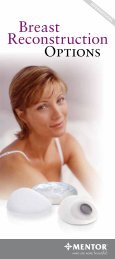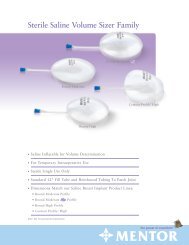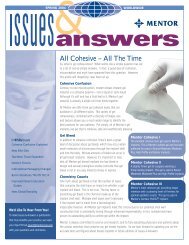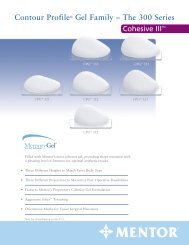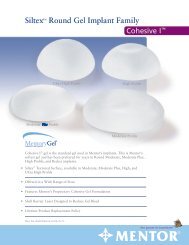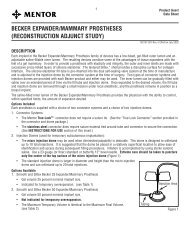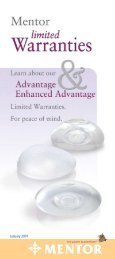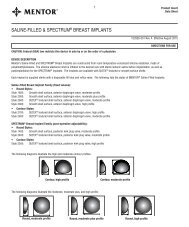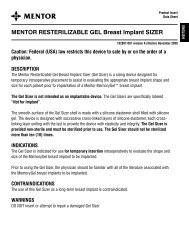becker expander/mammary prostheses - Mentor Worldwide LLC
becker expander/mammary prostheses - Mentor Worldwide LLC
becker expander/mammary prostheses - Mentor Worldwide LLC
You also want an ePaper? Increase the reach of your titles
YUMPU automatically turns print PDFs into web optimized ePapers that Google loves.
BECKER EXPANDER/MAMMARY PROSTHESES<br />
(RECONSTRUCTION ADJUNCT STUDY)<br />
1 Product Insert<br />
Data Sheet<br />
102757-001 Rev. E Effective July 2002<br />
DESCRIPTION<br />
Each implant in the Becker Expander/Mammary Prosthesis family of devices has a low-bleed, gel-filled outer lumen and an<br />
adjustable saline-fillable inner lumen. The resulting devices combine some of the advantages of tissue <strong>expander</strong>s with the<br />
feel of a gel <strong>mammary</strong>. In order to provide a prosthesis with elasticity and integrity, the outer and inner shells are made with<br />
successive cross-linked layers of silicone elastomer. The textured Siltex,* shell provides a disruptive surface for collagen<br />
interface. The silicone elastomer fill tube is pre-inserted into the dual self-sealing valve system at the time of manufacture<br />
and is adjoined to the injection dome by the connector system at the time of surgery. Two types of connector systems and<br />
injection domes are provided with each Becker product and either may be used. The inner lumen can be gradually filled with<br />
saline over an extended period of time via the fill tube and injection dome. Once expanded to the desired volume, the fill tube<br />
and injection dome are removed through a small incision under local anesthetic, and the prosthesis remains in position as a<br />
breast implant.<br />
The saline-filled inner lumen of the Becker Expander/Mammary Prosthesis provides the physician with the ability to control,<br />
within specified limits, the amount of expansion desired.<br />
Options Included<br />
Each prosthesis is supplied with a choice of two connector systems and a choice of two injection domes.<br />
1. Connector Systems:<br />
• The <strong>Mentor</strong> True-Lock ® * connector does not require a suture tie. (See the “True-Lock Connector” section provided in<br />
the connector and dome package.)<br />
• The stainless steel connector does require suture material tied around tube and connector to secure the connection.<br />
(See INSTRUCTIONS FOR USE section of this insert.)<br />
2. Injection Domes (used for temporary subcutaneous implantation):<br />
• The micro injection dome may be used when diminished palpability is desirable. This dome is designed to withstand<br />
up to 10 total injections. It is suggested that the dome be placed in a relatively superficial location to allow ease of<br />
identification and access during subsequent filling procedures. Inflation is accomplished by using sterile isotonic<br />
saline. Use a 23 gauge (or finer) standard or butterfly 12° bevel needle. Extreme care should be taken to puncture<br />
only the center of the top surface of the micro injection dome (Figure 1).<br />
• The standard injection dome is larger in diameter and height than the micro injection<br />
dome and can withstand up to 20 total injections.<br />
Options Available<br />
1. Smooth and Siltex Becker 25 Expander/Mammary Prosthesis<br />
• Gel volume 25 percent nominal implant size.<br />
• Indicated for temporary overexpansion. (see Table 1)<br />
Injection Area<br />
2. Smooth and Siltex Becker 50 Expander/Mammary Prosthesis<br />
• Gel volume 50 percent nominal implant size.<br />
• Not indicated for temporary overexpansion.<br />
• The Maximum Temporary Volume is identical to the Maximum Final Volume. Tubing<br />
(see Table 2)<br />
Figure 1
2<br />
INCLUSION CRITERIA<br />
• One or more of the following indications:<br />
- Immediate or delayed breast reconstruction following mastectomy.<br />
- Reconstruction due to cancer treatments other than mastectomy.<br />
- Revision due to complications or other undesirable results of a previous surgery for mastectomy or cancer treatments<br />
other than mastectomy.<br />
- Post-Trauma defined as total or partial removal of the breast(s) through surgery (for any reason) or as a result of the<br />
trauma itself.<br />
- Congenital deformities: Pectus Excavatum defined as congenital concave chest-wall deformity with abnormalities of<br />
the sternum and anterior ribs; Pectus Carinatum defined as congenital convex chest-wall deformity with abnormalities<br />
of the sternum and anterior ribs; and severe asymmetry defined as congenital or acquired substantial discrepancy in<br />
breast sizes such as to represent a significant physical deformity (e.g., Poland’s syndrome).<br />
- Severe ptosis defined as requiring a specific reconstruction procedure (e.g., mastopexy).<br />
- Patients who require revision for implant replacement for severe deformity caused by medical or surgical<br />
complications, regardless of original indication for implantation or type of device originally implanted.<br />
- Patients who require augmentation mammaplasty in the unaffected breast as a result of the surgery, due to one of the<br />
above Indications, in the affected breast (e.g., unilateral mastectomy with augmentation to opposite breast to provide<br />
symmetry).<br />
- Replacement or revision for patients whose prior surgery was not a result of treatment for cancer and for whom saline<br />
implants are unsuitable (e.g., skin too thin, insufficient tissue, etc.) as deemed by the surgeon.<br />
- Special circumstances for implantation will be considered on a case-by-case basis per written FDA authorization.<br />
• Determined by a physician not to be a candidate for saline-filled <strong>mammary</strong> implants, due to skin being too thin,<br />
insufficient tissue, etc.<br />
• Patient must be willing to follow the Reconstruction Adjunct Study requirements.<br />
EXCLUSION CRITERIA<br />
When used in the Reconstruction Adjunct Study, the use of this prosthesis is contraindicated in patients who have any of the<br />
following conditions:<br />
• An active infection or abscess anywhere in the body.<br />
• Pregnancy or nursing mothers.<br />
• Lupus (e.g., SLE and DLE).<br />
• Scleroderma (e.g., progressive systemic sclerosis).<br />
• Uncontrolled diabetes or other disease which impacts healing.<br />
• Tissue characteristics which are clinically incompatible with mammaplasty (e.g., tissue damage resulting from radiation,<br />
inadequate tissue, compromised vascularity or ulceration).<br />
• History of sensitivity to foreign materials or repeated attempts and failures at breast reconstruction or augmentation.<br />
• Possess any condition or currently be under treatment for any condition which, in the plastic surgeon’s and/or consulting<br />
physician’(s) opinion, may constitute an unwarranted surgical risk.<br />
• An unwillingness to undergo any further surgery for revision.<br />
• Psychological characteristics such as inappropriate attitude or motivation which, in the surgeon’s opinion, are<br />
incompatible with the surgical procedure and prosthesis.<br />
• Augmentation mammaplasty and the failure to have at least one of the diagnoses identified in the INCLUSION CRITERIA.<br />
NOTE: The satisfactory use of this prosthesis for tissue replacement following mastectomy may require special<br />
reconstructive procedures, particularly in the presence of radiation damage on the chest-wall, tight thoracic skin, thoracic<br />
skin grafts or radical resection of the pectoralis major muscle.
3<br />
PATIENT EDUCATION AND INFORMED CONSENT<br />
The surgical procedures associated with the use of tissue <strong>expander</strong>s and <strong>mammary</strong> <strong>prostheses</strong> are not without potential<br />
complications and risks. The use of this product is an elective procedure. The patient should be counseled prior to surgery<br />
regarding the benefits and possible risks associated with tissue reconstruction using tissue <strong>expander</strong>s, breast <strong>prostheses</strong> and<br />
alternative procedures. Patients should be advised that breast implants should not be considered lifetime implants due to the<br />
inherent nature of silicone implants, implant procedures and potential physiological reactions. An Informed Consent<br />
document is provided for this product. This must be read, understood and signed by the patient prior to surgery.<br />
It is the responsibility of the individual surgeon to decide the best method by which to counsel a patient prior to surgery.<br />
<strong>Mentor</strong> relies upon the surgeon to advise the patient of all potential complications and risks associated with the use of<br />
<strong>mammary</strong> <strong>prostheses</strong>.<br />
INSTRUCTIONS FOR USE<br />
The implantation of gel-filled <strong>prostheses</strong> or tissue <strong>expander</strong>s for breast reconstruction involves a variety of surgical<br />
techniques; therefore, the surgeon is best advised to use the method which his/her own practice and discretion dictate to be<br />
best for the patient. The procedures listed below are recommended by <strong>Mentor</strong> for breast <strong>prostheses</strong> or tissue <strong>expander</strong>s.<br />
Implant Selection<br />
Some of the important surgical and implant sizing variables that have been identified include the following:<br />
• The implant should not be too small or too large in comparison to the patient’s chest-wall dimensions.<br />
• Available tissue must provide adequate coverage of the implant.<br />
• Submuscular placement of the implant may be preferable in patients with thin or poor quality tissue.<br />
• A well-defined dry pocket of adequate size and symmetry must be created to allow the implant to be placed flat on a<br />
smooth surface.<br />
NOTE: It is advisable to have more than one size Becker/Expander Mammary Prosthesis in the operating room at the time of<br />
surgery to allow for flexibility in determining the appropriate size implant to be used. A backup implant should also be available.<br />
Testing Procedure for Becker Expander/Mammary Implants<br />
The device should be tested for patency and shell integrity immediately prior to use. Partially inflate the device with air or<br />
saline through the fill tube, taking care not to damage the tube. Visually inspect the device for leakage and for any corruption<br />
of the outer shell, using firm hand manipulation. Remove any air from the device prior to filling.<br />
Filling and Connection Procedure<br />
1. Prior to inserting the prosthesis into the surgically<br />
prepared pocket, deflate the device completely via the<br />
two-way check valve. The two-way check valve<br />
opens when a syringe is attached, and closes when<br />
the syringe is removed. The luer adapter and check<br />
Luer Adapter<br />
valve are used to facilitate intraoperative filling of the<br />
device, and must not be implanted (See Figure 2).<br />
2. Before connecting the fill tube to the injection dome,<br />
trim the device tube and discard the luer adapter and<br />
check valve. Connect the fill tube to the desired<br />
Two-way check Valve<br />
injection dome using one of the connectors supplied.<br />
Care should be taken to tailor the length of the tube so<br />
Figure 2<br />
that it will not kink or shorten as the implant expands.<br />
NOTE: If using the stainless steel connector, nonabsorbable suture material should be tied around the tube and connector<br />
(Figure 3) to secure the connection. It is important to securely tie the fill tube both distally and proximally to<br />
the connector so the entire fill tube assembly will be removed when the injection dome is removed from the patient.<br />
Care must be taken to secure the tube to the connector with ligatures in such a manner as to avoid cutting or occluding<br />
the tube or connector.<br />
1 /2<br />
1<br />
11 /2<br />
B-D<br />
2OZ
4<br />
Caution: The use of forceps or hemostats to aid in the connection and<br />
suture tying process is specifically contraindicated as tube or connector<br />
damage may lead to deflation and/or rupture of the device.<br />
Instructions for use of the True-Lock connector are included in the connector<br />
and dome package. Read these instructions carefully before using this<br />
connection system. It is important to securely assemble both sides of the fill<br />
tube to the connector so that the entire fill tube assembly will be removed<br />
when the injection dome is removed from the patient. (See PRECAUTIONS<br />
section of this insert.)<br />
3. The following instructions for implanting the Becker 25 Expander/Mammary<br />
Prosthesis as a reconstructive implant have been provided by Dr. Hilton Becker<br />
for informational purposes only1 . (Instructions for the Becker 50 follow.):<br />
Figure 3<br />
• An incision is made through the serratus anterior muscle at the level of the 6th to 7th rib. A large pocket is dissected<br />
in the submuscular space behind the pectoralis major muscle and is extended beneath the insertion of the rectus<br />
abdominus muscle.<br />
• The deflated implant is placed in the submuscular space and saline is injected through the fill tube by a syringe to the<br />
point where the implant takes up the slack skin. This usually does not exceed one-third of the total designated fill<br />
volume of the implant, depending upon the amount of skin available and the circulation to the skin. If the circulation<br />
appears to be compromised, no additional saline should be added at this stage.<br />
• The injection dome is then attached to the fill tube using the True-Lock connector system. The injection dome is then<br />
secured in a subcutaneous pocket adjacent to the device (generally below the axilla). Care must be taken to tailor the<br />
tube length to the patient so that it will not kink or shorten as the implant expands. The skin flaps are approximated<br />
and sutured in layers.<br />
Caution: Postoperative filling of the implant is started as soon as viability of the skin flaps is assured, usually within<br />
the first few days postoperatively. If the skin flaps appear to be compromised, saline should be removed from the<br />
implant.<br />
Expansion<br />
• Up to 100cc of saline are added twice weekly by percutaneous injection into the<br />
injection dome. One of three types of needles may be used to inflate the implant:<br />
a 21-gauge (or smaller) standard needle, a butterfly 12° bevel needle, or a hubertip<br />
needle. The needle must be inserted into the top of the injection dome (see<br />
Figure 4). The butterfly needle, however, is inserted at a 90° angle, staying within<br />
the top portion of the dome. Care should be taken not to puncture the dome’s<br />
radius or tube flange, as leakage may result. (Refer to the directions for use of the<br />
micro injection dome in the Options Included section of this insert when a smaller<br />
dome is indicated.) Expansion continues until the desired size is obtained. Care<br />
must be taken not to inflate the device beyond its specified limits.<br />
4. The following surgical procedure for using the Siltex Becker 50 Expander/Mammary<br />
Prosthesis has been provided by Dr. John Gibney for informational purposes only2 :<br />
Delayed Breast Reconstruction<br />
Injection<br />
Area<br />
• An infra<strong>mammary</strong> incision is used for delayed breast reconstruction. This allows better dissection under the<br />
pectoralis major muscle and establishes an anchor at the infra<strong>mammary</strong> fold. The scar acts as a fulcrum and<br />
prevents the implant from sliding down onto the rectus fascia.<br />
• An incision is made in the pectoralis major muscle underneath the existing mastectomy scar. In the inferior portion of<br />
the muscle no attempt is made to re-establish the origin of the muscle or to close the muscle.<br />
• Blunt dissection is used to approximately 1 cm greater than the size of the implant.<br />
• The fibers of the origin of the pectoralis major muscle are released from the lateral sternal margin. This allows medial<br />
movement of the implant, resulting in better cleavage.<br />
30<br />
30<br />
Figure 4
5<br />
• No attempt is made to elevate the serratus anterior laterally. Normally the abdominal portion of the flap is thick<br />
enough so that protection by the muscle is not necessary laterally.<br />
• Sutures are placed in the deep anterior fascia. Sutures should be placed prior to placement of the implant to help<br />
avoid inadvertent puncturing of the implant.<br />
• The lateral aspect of the mastectomy scar is opened and a separate subcutaneous pocket is created for the injection<br />
dome.<br />
Immediate Breast Reconstruction<br />
• For immediate breast reconstruction, the mastectomy incision is used for insertion of the prosthesis. In the interest<br />
of infra<strong>mammary</strong> fullness, or ptosis, it is necessary to create a submuscular pocket and an inferior fascial/fat flap<br />
(toward the muscle).<br />
• Undermining of the inferior flap extends to the level of the previous infra<strong>mammary</strong> fold, both above the fascial flap<br />
(toward the skin) and below the fascial flap (toward the muscle).<br />
• An incision is made through the pectoralis major at the level of the 5th rib. The submuscular pocket is dissected.<br />
• The origin of the pectoralis major is released from the sternal margin at the 4th to 6th rib.<br />
• The fascial flap is attached to the muscle. Thus, placement of the implant is primarily submuscular with the inferior<br />
approximately one-fourth placed subfascially. This placement ensures that the implant will not ride up superiorly in<br />
the pocket, and allows easier expansion of the tissue.<br />
• The injection dome is placed subcutaneously over the 4th rib at the midaxillary line.<br />
5. It is suggested that the injection dome and tube be placed high in the subcutaneous tissue adjacent to the device to allow<br />
easy identification and access during subsequent filling. The dome should be placed no less than three inches from the<br />
prosthesis to avoid damage to the device during postoperative filling. Inflation is accomplished by using sterile, pyrogenfree<br />
sodium chloride USP solution for injection. Use a 23-gauge (or finer) standard or butterfly needle. Extreme care<br />
should be taken to puncture only the center of the top surface of the injection dome at an angle perpendicular ± 30° to<br />
the top surface (Figure 4).<br />
6. Before closing the surgical incisions, confirm that the device is patent. This can be accomplished by inserting the<br />
23-gauge butterfly needle with syringe attached, into the injection dome, infusing or withdrawing solution and observing<br />
for proper inflation/deflation of the prosthesis.<br />
7. Entrapped air may be removed by using the attached filling syringe. Any remaining air will eventually diffuse out and be<br />
absorbed by tissue.<br />
Caution: At the time of wound closure, extreme care should be taken not to damage the prosthesis with surgical<br />
instruments. Preplacement of deep sutures may help to avoid inadvertent product contact with suture needles and<br />
subsequent product damage.<br />
Postoperative Expansion Procedure<br />
1. Use a syringe filled with pyrogen-free, sodium chloride USP solution for injection to inflate the prosthesis to the<br />
recommended volume. Only sterile, pyrogen-free, sodium chloride USP solution for injection drawn from its original<br />
container should be used.<br />
2. Once expansion is completed, the injection dome and fill tube are removed. Make a small incision at the location of the<br />
injection dome. It is important to grasp beyond the connector and remove the tube before taking out the injection<br />
dome. This prevents the tube from dislodging and retracting back into the pocket. Trace amounts of gel may appear on<br />
the tube during its removal from the device. Do not pull on the connector while removing the tube as it may disconnect<br />
and subsequent deflation could occur. Use a slow and steady traction to remove the fill tube and thus prevent damage to<br />
the prosthesis or its self-sealing valve. (See PRECAUTIONS and WARNINGS sections of this insert.)<br />
Caution: The Final Expansion Volume should not be less than the Minimum Recommended Volume or greater than the<br />
Maximum Recommended Volume (see Table 1, 2). Underfilled <strong>prostheses</strong> may buckle, fold or wrinkle causing<br />
crease/fold failure of the device and subsequent deflation and/or rupture can occur. Inflation beyond the Maximum<br />
Recommended Volume may also cause crease/fold failure or shell rupture.
6<br />
3. The patient must be monitored during the volume adjustment period to guard against sloughing, necrosis, wound<br />
dehiscence and other complications associated with tissue expansion. If at any time the overlying tissue exhibits any of<br />
these symptoms, the device should be reduced in volume by reversing the filling procedures and withdrawing fluid from<br />
the prosthesis. If signs persist, the device must be removed.<br />
NOTE: It is recommended that the duration of expansion not exceed six months as tissue adhesions may make it difficult to<br />
easily remove the fill tube or compromise valve integrity. Damage to the implant may result. <strong>Mentor</strong> recommends timely<br />
volume adjustment of the device. Upon achievement of the desired expansion result, the fill tube and injection dome must be<br />
removed.<br />
For expansion guidelines see:<br />
Table 1: Becker 25 Expander/Mammary Prosthesis<br />
Table 2: Becker 50 Expander/Mammary Prosthesis<br />
Fill-tube Removal:<br />
The fill tube in the Becker Expander/Mammary Prostheses is pre-inserted in the device and should be handled carefully.<br />
Note: The tubing should be removed from the implant prior to disconnecting the injection dome.<br />
1. Once expansion is completed, the injection dome and fill tube are removed. Make a small incision at the location of the<br />
dome.<br />
2. It is important to grasp the tubing beyond the connector and as close to the implant as possible. Avoid instrument<br />
damage to the fill tube which may result in tube breakage, retraction of the tube into the pocket and subsequent deflation<br />
and/or rupture of the device.<br />
3. Place the opposite hand on the <strong>expander</strong>/implant to secure it in place while pulling the fill-tube.<br />
4. Exert a slow, steady, even force when withdrawing the fill tube. If the fill tube turns white, relax the tube and re-grasp<br />
the fill tube closer to the implant. Again, exert a slow, steady, even force to withdraw the tube.<br />
5. Gentle massage of the <strong>expander</strong>/implant and valve while withdrawing the tube may help facilitate removal.<br />
6. Please review the Product Insert Data Sheet for additional Instructions, Precautions and Warnings.<br />
Recording Procedure for Becker Expander/Mammary Prostheses<br />
Each prosthesis is supplied with a Patient Record Label showing the catalog number, lot number and serial number (if<br />
applicable) for that unit. One of these pressure-sensitive labels should be attached directly to the Patient Registry Enrollment<br />
Form, and one to the patient’s chart. The implanted position (left or right side) of each prosthesis and date of surgery should<br />
be indicated on the label. The fill volume of each prosthesis should be indicated on the label also.<br />
HOW SUPPLIED<br />
Becker Expander/Mammary Prostheses and accessories are supplied individually in a sterile and nonpyrogenic double-wrap<br />
packaging system. The double-wrap system facilitates the preferred method of sterile product transfer from the circulating<br />
area to the sterile field. Sterility cannot be guaranteed if the double-wrap packaging system has been damaged.<br />
This product is recommended for single use only.<br />
PRECAUTIONS<br />
• Pre-existing infection should be treated and resolved before implantation of the prosthesis.<br />
• It is possible that bubbles may form in the silicone gel as a result of the manufacturing or sterilization process. These<br />
bubbles will not detract from the safety or efficacy of the prosthesis, and will diffuse and dissipate of their own accord.<br />
• Any surgeon performing reconstructive mammaplasty with implants should be familiar with the currently available<br />
techniques for measuring the patient, determining implant size and performing surgery. (See INSTRUCTIONS FOR USE<br />
section of this insert.)<br />
• Lint, dust, talc, surgical glove powder, drape and sponge lint, fingerprints, skin oils and other surface contaminants<br />
deposited on an implant by improper handling may cause foreign body reactions. Strict adherence to clean, aseptic<br />
techniques should be maintained to prevent contamination of the implant and possible complications. Surgical<br />
instruments and gloves should be rinsed clean of any impurities before handling the implant.
7<br />
• The dual self-sealing valve of the Becker Expander/Mammary family of <strong>prostheses</strong> is unique and may be unfamiliar to the<br />
surgeon. The fill tube is inserted into the prosthesis at the time of manufacture and should be handled carefully to avoid<br />
accidental dislodgment from its prepositioned location. Do not hold the device by its fill tube.<br />
• The silicone elastomer shell, fill tube and injection dome may be easily cut by a scalpel or ruptured by excessive stress,<br />
manipulation with blunt instruments or penetration by a needle. Subsequent deflation and/or rupture will result. All products<br />
should be carefully inspected for structural integrity prior to and during implantation.<br />
• Meticulous care must be exercised in handling, connecting and implanting the device.<br />
• Any subsequent surgical procedures in the area of the implant should be undertaken with extreme caution as damage to<br />
the implant could occur. In the event that an implant is damaged, it must be removed.<br />
• Each device should be checked for patency prior to surgery and continuously monitored throughout the surgical procedure<br />
to ensure the structural integrity of the device is not compromised in any way. This prosthesis should not be implanted<br />
following any modifications to its original design. A prosthesis which has been damaged, or on which repairs or<br />
modifications have been attempted, should not be implanted. A standby prosthesis should be available at the time of<br />
surgery.<br />
• When removing the fill tube and injection dome, the fill tube should be removed first. Grasp the fill tube beyond the<br />
connector to prevent separation of the injection dome from the fill tube. Do not exert sudden or undue tension on the<br />
fill tube during removal. Avoid instrument damage to the fill tube which may result in tube breakage, retraction of tube<br />
into the pocket and subsequent deflation and/or rupture of the device.<br />
• Tissue ingrowth can occur when using the True-Lock connector. Surgeons should anticipate the need to dissect the<br />
capsule prior to removing the fill tube and injection dome. Grasp beyond the connector and remove the tube before<br />
taking out the injection dome.<br />
• Do not contact the device with disposable, capacitor-type cautery instruments as damage to the outer shell of the<br />
prosthesis may result.<br />
• The tube which connects the implant to the injection dome should be carefully sized to avoid kinks. Careful attachment of<br />
the fill tube to the connector is important to prevent separation. Failure of the device to inflate may be due to kinking of<br />
the tube, leakage, separation of the components or injections which do not penetrate the injection dome.<br />
• Extreme care should be taken when connecting the fill tube to the connector. The tube is easily damaged with surgical<br />
instrumentation (e.g., forceps contact), and their use should be avoided.<br />
• Surgeons should ensure themselves of the position of the injection dome prior to adding or withdrawing fluid.<br />
• Potential for contamination exists when fluid is added to or removed from the device. Use aseptic technique in the<br />
introduction of saline into the implant; a single-use, sterile saline container is recommended.<br />
Additional Precautions for Becker Expander/Mammary Prostheses:<br />
• Avoid too small an incision. A larger incision than is normally used for smooth-shelled <strong>expander</strong>/<strong>mammary</strong> implants<br />
may be required to facilitate insertion and to avoid damage to the device. A device which is damaged during insertion<br />
may result in postoperative deflation and/or rupture.<br />
• <strong>Mentor</strong> recommends the surgeon consider the size of implant and the firmer nature and higher profile of the Siltex shell<br />
when choosing optimum incision size and surgical approach. Certain surgical approaches may cause higher stresses on<br />
the device during implantation.<br />
WARNINGS<br />
It is the responsibility of the surgeon, and <strong>Mentor</strong> relies on the surgeon, to advise the patient of all potential risks and<br />
complications associated with the proposed surgical procedure and device, including providing a comparison of the risks and<br />
complications of alternative procedures. Patients should be advised that breast implants should not be considered<br />
lifetime implants due to the inherent nature of silicone implants, implant procedures and potential physiological reactions.<br />
• At the time of incision closure, extreme care should be taken not to damage the prosthesis with surgical instruments.<br />
Such contact may result in immediate or delayed shell deflation and/or rupture. Preplacement of deep sutures may help<br />
to avoid inadvertent product contact with suture needles and subsequent product damage.
8<br />
• This product is for single use only. The possibility of damage to the implant and infection exists if a subsequent<br />
procedure is performed, such as an open capsulotomy, breast pocket revision, etc. It is the responsibility of the attending<br />
physician to determine if a new implant should be inserted. If the implant is damaged, it must be removed.<br />
• Silicone gel can leak or “bleed” through the semipermeable outer silicone envelope into the capsule and adjacent breast<br />
tissue. Migration into capillaries has also been reported. The long-term effects of such “bleed” are unknown.<br />
Prospective patients should be made aware of this potentiality. (See ADVERSE REACTIONS section of this insert.)<br />
• Only one prosthesis should be implanted per breast. <strong>Mentor</strong> recommends against the stacking of implants, one upon the<br />
other. The devices have not yet been tested for this use and the integrity of the implants cannot be guaranteed as the<br />
materials may abrade and wear. Such abnormal stress may result in weakening or deflation/rupture of the <strong>prostheses</strong>.<br />
• Do not insert or attempt to repair a damaged or altered prosthesis.<br />
• The action of drugs (examples: antibiotics and steroids) in contact with the prosthesis has not been tested by the<br />
manufacturer, and their use cannot be recommended.<br />
• In vitro testing has demonstrated that even low concentrations of Betadine ® * solution placed within the breast implant<br />
will compromise implant integrity in the long term. Therefore, we recommend that no Betadine solution or other<br />
antibacterial, antiseptic, or cleaning agent be added to the injection media. If a cleaning solution is to be used within the<br />
implant surgical space, the site should be carefully rinsed to remove the residual solution.<br />
• Do not introduce or make injections of drugs or other substances into the implant. Injections through the implant shell<br />
will compromise the product’s integrity, causing it to leak fluid and eventually deflate and/or rupture.<br />
• Preoperative evaluation of the implant design, size and implant site should include allowances for adequate tissue<br />
coverage. Pressure, force, tension and other stresses to which the implant site will be susceptible must be considered.<br />
• Excessive inflation of the device may result in tissue necrosis/thrombosis.<br />
• Final Expansion Volume should not be less than the Minimum Recommended Volume or more than the Maximum<br />
Recommended Volume (see Table 1, 2). Underfilled <strong>prostheses</strong> may buckle, fold or wrinkle causing crease/fold failure of the<br />
device, and subsequent deflation and/or rupture can occur. Inflation beyond the Maximum Recommended Volume may also<br />
cause crease/fold failure or shell rupture.<br />
• Sepsis, hemorrhage or thrombosis may result from the placement of any foreign object in the body.<br />
• The use of microwave diathermy in patients with breast implants has been reported to cause tissue necrosis, skin erosion<br />
and extrusion of the implant. Its use in patients with breast implants is not recommended.<br />
• The patient should be made aware that any abnormal stress or trauma to the breast could result in rupture of the<br />
prosthesis. The gel portion of this product is vulcanized to retard the migration of gel should a rupture occur in the<br />
silicone envelope. However, should the silicone envelope be ruptured, <strong>Mentor</strong> cannot guarantee reliable gel containment<br />
and the prosthesis must be immediately removed. The long-term biological effects of silicone gel are currently unknown.<br />
A burning sensation and change or loss of breast shape may be symptoms of implant rupture; however, implants can<br />
rupture without symptoms. Women should be advised to see their physician immediately if they suspect that their<br />
implant has ruptured.<br />
• <strong>Mentor</strong> strongly recommends against the use of closed capsulotomy to treat capsule firmness. <strong>Mentor</strong> is not responsible<br />
for the structural integrity of the implant should the surgeon elect to perform such a procedure. If the physician uses this<br />
technique, several complications may occur: hematoma, displacement of the implant and/or shell rupture. The physician<br />
should inform the patient of these potential complications and of alternatives to the procedure. Capsule firmness must not<br />
be treated by over-expansion of the device. Such abnormal stress or trauma to the breast and the prosthesis could result in<br />
rupture of the prosthesis.<br />
• The American College of Radiology has stated that mammography may be less effective on implanted breasts and may<br />
interfere with early detection of breast cancer. The mammographer should be trained and experienced with the most current<br />
radiologic techniques and equipment. This may increase cost and radiation exposure to the patient. Patients should inform<br />
the mammographer that they have breast implants and should also be instructed how to distinguish the prosthesis from<br />
normal or abnormal breast tissue during self-examinations for breast cancer.<br />
*Betadine® is a registered trademark of the Purdue Frederic Company.
9<br />
• Careful hemostasis is important to prevent postoperative hematoma formation. Should excessive bleeding persist, it is<br />
recommended that the device not be implanted until the bleeding is controlled.<br />
• If a physician treats a hematoma or serous fluid accumulation by aspiration, or if a biopsy or lumpectomy is performed,<br />
care must be taken to avoid damaging the implant. These procedures present possible risk of implant puncture.<br />
• The incidence of extrusion of the prosthesis has been shown to increase when the prosthesis has been placed in injured<br />
areas: scarred, heavily irradiated or burned tissue, crushed bone areas or where severe surgical reduction of the area has<br />
previously been performed.<br />
• Excessive fibrous capsular formation or contracture may occur around any implant placed in contact with soft tissues.<br />
The incidence and severity of this occurrence may increase if postoperative local hematoma or infection occurs.<br />
• The physician should use personal discretion when deciding to use these <strong>prostheses</strong> regarding patients who exhibit<br />
psychological instability.<br />
• Granulomas are non-cancerous lumps that can form when certain body cells surround foreign material, such as silicone.<br />
Like any lump, it should be further evaluated to distinguish it from a lump that might be cancerous and may require a<br />
biopsy.<br />
• Preliminary animal studies show no evidence that birth defects are caused by breast implants. However, to rule out that<br />
possibility for humans, further scientific studies are necessary to show whether or not breast implants are associated with<br />
birth defects.<br />
• Surgical implantation of a <strong>mammary</strong> prosthesis may interfere with the ability to breast feed. However, it should be noted<br />
that previous breast reconstruction surgery, such as mastectomy, may be the initial cause of this interference.<br />
ADVERSE REACTIONS<br />
Any patient undergoing a surgical procedure is subject to possible unforeseen operative and postoperative complications.<br />
Potential reactions and complications associated with the use of the Becker Expander/Mammary Prostheses should be discussed<br />
with and understood by the patient prior to surgery. It is the responsibility of the surgeon, and <strong>Mentor</strong> relies on the<br />
surgeon, to provide the patient with this information and to weigh the risk/benefit potential for each patient.<br />
Complications which may result from the use of this product include the risks associated with the medication and methods<br />
used in the surgical procedure as well as the patient’s degree of intolerance to any foreign object placed in the body. The<br />
complications may include, but are not limited to, the following:<br />
Capsule Formation and Contracture<br />
• Postoperative formation of a fibrous tissue capsule around a <strong>mammary</strong> prosthesis is a normal physiologic response to<br />
the implantation of a foreign object in soft tissues. Capsule formation occurs in all patients in varying degrees. Capsules<br />
range from thin to heavily thickened.<br />
• Contracture of the fibrous capsule may occur, independent of its thickness. Discomfort, pain, excessive breast firmness,<br />
misshapen breast, deflation and/or rupture, increased palpability, wrinkling and/or displacement of the prosthesis may<br />
occur and may require surgical intervention. In some patients, breast firmness may recur subsequent to corrective<br />
surgical procedures. <strong>Mentor</strong> strongly recommends against the use of closed capsulotomy to treat capsule firmness.<br />
• Capsular contracture can also make the detection of breast cancer more difficult.<br />
• Cases of calcification of the fibrous capsule have occurred, necessitating removal of the implant and/or the fibrotic<br />
calcareous capsule.<br />
• Any surgery or injury to the breast can produce small spots of calcium in the breast tissue which can be seen on X-rays.<br />
These deposits may not occur until years after implant surgery. They are benign and cause no problems but must be<br />
differentiated from the calcium that is often seen in breast cancers. An expert radiologist can usually determine if a<br />
calcium spot is benign or malignant, but occasionally a biopsy may be necessary. Some patients may develop a thin layer<br />
of calcium in the scar capsule that surrounds the implant. This is almost always associated with capsular contracture but<br />
otherwise causes no known problem.<br />
Rupture/Deflation of the Implant<br />
Breast implants are not lifetime devices and cannot be expected to last forever. Some implants deflate or rupture in the<br />
first few months after being implanted and some deflate after several years; others are intact 10 or more years after the<br />
surgery.
10<br />
Silicone Gel-Filled Breast Implants – When silicone gel-filled implants rupture, some women may notice decreased breast<br />
size, nodules (hard knots), uneven appearance of the breasts, pain or tenderness, tingling, swelling, numbness, burning,<br />
or changes in sensation. Other women may unknowingly experience a rupture without any symptoms (i.e., “silent rupture”).<br />
Magnetic resonance imaging (MRI) with equipment specifically designed for imaging the breast may be used for<br />
evaluating patients with suspected rupture or leakage of their silicone gel-filled implant.<br />
Silicone gel which escapes the fibrotic capsule surrounding the implant may migrate away from the breast. The free silicone<br />
may cause lumps called granulomas to form in the breast or other tissues where the silicone has migrated, such as<br />
the chest wall, armpit, arm, or abdomen.<br />
Plastic surgeons usually recommend removal of the implant if it has ruptured, even if the silicone is still enclosed within<br />
the scar tissue capsule, because the silicone gel may eventually leak into surrounding tissues. If you are considering the<br />
removal of an implant and the implantation of another one, be sure to discuss the benefits and risks with your doctor.<br />
FDA completed a retrospective study on rupture of silicone gel-filled breast implants. 1 This study was performed in<br />
Birmingham, Alabama and included women who had their first breast implant before 1988. Women with silicone gelfilled<br />
breast implants had a MRI examination of their breasts to determine the status of their current breast implants.<br />
The 344 women who received a MRI examination had a total of 687 implants. Of the 687 implants in the study, at least<br />
two of the three study radiologists agreed that 378 implants were ruptured (55%). This means that 69% of the 344<br />
women had at least one ruptured breast implant. Of the 344 women, 73 (21%) had extracapsular silicone gel in one or<br />
both breasts. Factors that were associated with rupture included increasing age of the implant, the implant manufacturer,<br />
and submuscular rather than subglandular location of the implant. A summary of the findings of this study is also<br />
available on FDA’s website at http:/www.fda.gov/cdrh/breastimplants/studies/biinterview.pdf and<br />
http:/www.fda.gov/cdrh/breastimplants/studies/birupture.pdf.<br />
Robinson et al. studied 300 women who had their implants for 1 to 25 years and had them removed for a variety of<br />
reasons. 2 Visible signs of rupture in 51% of the women studied were found. Severe silicone leakage (silicone outside<br />
the implant without visible tears or holes) was seen in another 20%. Robinson et al. also noted that the chance of<br />
rupture increases as the implant ages.<br />
Other studies indicate that saline may escape the capsule in 11-23% of rupture cases. 3,4,5,6<br />
To evaluate the risk to the patient of prosthesis rupture, patients must be monitored for a minimum of 10 years. The<br />
manufacturer of this prosthesis is currently collecting information on the incidence of rupture of this device. Implants that<br />
rupture usually require explantation and replacement; however, implants can rupture without noticeable symptoms. Causes<br />
of rupture and/or deflation of implants include, but are not limited, to the following events:<br />
• Damage from surgical instruments.<br />
• Intraoperative or postoperative trauma.<br />
• Excessive stresses or manipulations as may occur during daily routines such as vigorous exercise, athletics, routine manual<br />
massage and intimate physical contact.<br />
• Mechanical damage prior to or during surgery.<br />
• Valve malfunctions or tissue ingrowth into the valve.<br />
__________________________<br />
1 Brown SL, Middleton MS, Berg WA, Soo MS, Pennello G. Prevalence of rupture of silicone gel breast implants in a population of women in<br />
Birmingham, Alabama. American Journal of Roentgenology 2000; 175-1-8.<br />
2 Robinson OG, Bradley EL, Wilson DS. Analysis of explanted silicone implants: a report of 300 patients. Ann Plast Surg. 1995; 34:1-7.<br />
3 Vinnik CA. Migratory silicone – clinical aspects. Silicone in Medical Devises – Conference Proceedings. 1991 February 1-2; Baltimore, MD:<br />
U.S. Department of Health and Human Services, FDA Publication No. 92-4249 (p.59-67).<br />
4 Duffy MJ, Woods JE, Health risks of failed silicone gel breast implants: a 30-year clinical experience. Plast Reconstr Surg 1994;94:295-299.<br />
5 Berg WA, Caskey CI, Hamper UM, Kuhlman JE, Anderson ND, Chang BW, Sheth S, Zerhouni EA. Single- and double-lumen silicone breast<br />
implant integrity: Prospective evaluation of MR and US criteria. Radiology 1995;197:45-52.<br />
6 Gorczyca DP, Schneider E, DeBruhl ND, Foo TKF, Ahn CY, Sayre JW, Shaw WW, Bassett LW. Silicone breast implant rupture: Comparison<br />
between three-point Dixon and fast spin-echo MR imaging. AJR 1994;162-305-310.
11<br />
• Leakage from the tube or fill dome.<br />
• Underfilling or overfilling the device (see product label and Table 1 or 2).<br />
• Damage during fill tube removal.<br />
• Damage during the injection/filling stage.<br />
• Closed capsulotomy.<br />
• Capsular contracture.<br />
• Origins which are unknown.<br />
NOTE: More frequent intraoperative rupture is reported to occur with the use of too small an incision for introduction of the<br />
prosthesis.<br />
Infection<br />
• Infection, manifested by swelling, tenderness, pain and fever, may appear in the immediate postoperative period or at<br />
any time after insertion of the device. In the absence of classic symptoms, subacute or chronic infections may be difficult<br />
to diagnose. If infection does not subside promptly with the appropriate treatment, removal of the device is indicated.<br />
• Toxic Shock Syndrome has been reported as a complication of both augmentation and reconstructive mammaplasty.<br />
(See Possible Reactions to Silicone and Thermoplastic Elastomer.)<br />
Complications of Tissue Expansion<br />
• Tissue thinning.<br />
• Sloughing of poorly vascularized tissue.<br />
• Closed, postoperative hematoma, manifested by enlargement, tenderness and discoloration leading, if untreated, to<br />
extrusion of the device.<br />
• Undue pressure on the tissue located over the device or trauma to surrounding tissues which may lead to venous<br />
thrombosis, the breakdown of skin over the device and subsequent extrusion. Deflation or removal of the device may be<br />
necessary for tissue repair.<br />
Extrusion of Implant/Interruption of Wound Healing<br />
• Skin necrosis and/or sloughing may result from undue tension of the skin overlying the implant, trauma to the skin flap<br />
during surgical procedures or inadequate flap thickness inhibiting circulation. Subsequent exposure and/or extrusion of<br />
the implant may occur.<br />
• Displacement, twisting, fracture or extrusion may occur from improper implant sizing and/or placement, i.e., when the<br />
implant is too large or the pocket too small or when there has been inadequate preoperative assessment of stresses<br />
causing movement to the prosthesis.<br />
• The incidence of extrusion of the prosthesis has been shown to increase when the prosthesis has been placed in injured<br />
areas: scarred, heavily irradiated or burned tissue or crushed bone areas; where severe surgical reduction of the area has<br />
been performed; and where steroids are used in the breast pocket.<br />
Hematoma<br />
• Careful hemostasis is important to prevent postoperative hematoma formation. Should excessive bleeding persist, it is<br />
recommended that the device not be implanted until bleeding is controlled.<br />
• Gross postoperative hematoma, manifested by enlargement, tenderness and discoloration of tissue may, if untreated, lead<br />
to extrusion of the device.<br />
Fluid Accumulation<br />
• Excessive postoperative fluid accumulation and transient reaccumulation of fluid around the implant as a result of trauma<br />
and after vigorous exercise has been reported. Fluid accumulation appears to occur more frequently with textured<br />
implants.<br />
Dissatisfaction With Cosmetic Results<br />
• Incorrect implant size, inappropriate scar location or appearance and misplacement or migration of implants may interfere<br />
with a satisfactory cosmetic result. These complications are generally associated with the surgical procedure and technique.
12<br />
• Some patients may find valve palpability aesthetically undesirable.<br />
Wrinkling of the Implant<br />
• Some surgeons report that in certain patients, visible or palpable wrinkling of the envelope occurs. Folds in the envelope<br />
can be visible beneath the overlying skin. This is reported to occur more frequently with: thin-skinned patients; patients<br />
with little or no subcutaneous fat; subglandular rather than submuscular placement; an implant that is too large relative to<br />
the pocket size or frame of the patient; overlying tissue that is minimal or of poor quality; and/or when contracture is<br />
present.<br />
Asymmetry/Ptosis<br />
• The implanted breast may become ptotic over time, much like a natural breast.<br />
• In some instances, an excessively globular contour may give an unacceptable cosmetic result.<br />
• Failure to evacuate all the air from the prosthesis at the time of surgery may result in asymmetry of the breast and in the<br />
patient experiencing a sloshing or squishing effect.<br />
• Asymmetry may also be attributed to incorrect choice of implant shape or size, surgical technique, contracture of the<br />
fibrous capsule, seroma or hematoma, development of postoperative breast dysplasia, unilateral discrepancy in muscle<br />
development or deflation of the implant.<br />
Change in Nipple and Breast Sensation<br />
• Neural complications associated with breast implants have been reported. They include temporary or permanent<br />
anesthesia or hyperesthesia of a segment of the breast’s surface, particularly the nipple or areola.<br />
POSSIBLE REACTIONS TO SILICONE AND THERMOPLASTIC ELASTOMER<br />
Introduction<br />
This text contains a brief summary of information from the medical literature. The following information is mainly derived<br />
from literature and studies based on <strong>mammary</strong> implants but may also be relevant to other implants, <strong>prostheses</strong> and devices<br />
composed of like materials.<br />
<strong>Mentor</strong> recognizes that the information contained within this text is highly technical. However, medical ethics and practice<br />
dictate that the physician must be an intervening party between the manufacturer of prescriptive medical devices and the<br />
patient. In light of the foregoing, <strong>Mentor</strong> provides this text as an overview of current information to assist the physician in<br />
obtaining informed consent from the patient.<br />
The issue of the possible relationship between silicone (and other implantable materials) and various diseases has been and<br />
continues to be the subject of great scientific and medical debate.<br />
Articles continue to be published on a regular basis on this subject. Because of the dynamic nature of this issue, and because<br />
product information supplied by <strong>Mentor</strong> can only reflect a summary of information as of a specific point in time, <strong>Mentor</strong><br />
reminds the surgeons of their independent responsibility to keep abreast of scientific developments relating to devices they<br />
are prescribing and to provide prospective patients with the most up-to-date information.<br />
The association between silicone and other thermoplastic elastomers (hereafter “silicone”) and the following complications<br />
has not been verified by controlled scientific studies. However, there have been case reports in the medical literature<br />
associating these complications with silicone implants and devices. Toxicity studies are currently in progress by various<br />
research facilities, universities, government agencies, the medical community and the medical device industry. Some of these<br />
studies are conducted in animal models to determine potential immunotoxicity and autoimmune issues related to silicone<br />
materials. There is a potential that in the animal models being studied, immunotoxicity may result. The clinical significance<br />
of some of these studies has not been determined.<br />
IMMUNOLOGICAL AND NEUROLOGICAL RESPONSE<br />
The medical literature has raised the possibility that there may be an association between certain immunological-based<br />
diseases and silicone implants. The diseases most commonly mentioned include scleroderma, rheumatoid arthritis and<br />
syndromes which mimic systemic lupus erythematosus. Available information does not permit precise quantification of risk.<br />
Neurological problems have been reported in a small number of breast implant patients who also exhibit immunological<br />
symptoms. These reports do not prove a link between the implants and immunological or neurological problems.
13<br />
NOTE: If an immunological response is suspected, the physician must evaluate the necessity of removing the implant.<br />
Limited observations suggest that removal of silicone breast implants may alleviate symptoms in some patients who have<br />
developed rheumatic disease; however, this is not predictable (American College of Rheumatology 3/91.) The long-term<br />
effects of silicone in terms of immunological responses are currently unknown.<br />
Connective Tissue Disorders<br />
The term, Connective Tissue Disorders, has been used to describe a variety of symptoms thought to be related to silicone<br />
breast implants. Symptoms include, but are not limited to: skin lesions, alopecia, pyrexia, rash, swelling of joints, weight<br />
loss, chronic arthropathy, morphea, arthritis, general malaise and keratoconjunctivitis. Some cases of these disorders have<br />
been reported in women with breast implants, and some of these women have reported a reduction in symptoms after their<br />
implants were removed. Manufacturers are sponsoring large-scale scientific studies to explore whether a possible link exists<br />
between silicone breast implants and connective tissue disorders; however, to date there is no evidence to suggest that the<br />
prevalence of these disorders is greater among women who have received silicone implants than among the general agematched<br />
female population.<br />
BIOCOMPATIBILITY<br />
Reports in the medical literature suggest that host biocompatibility responses may be affected by different biomedical<br />
polymers by altering fibroblast production and function, and selectively modulating monocyte/macrophage activity and<br />
induction of Interleukin 1 (IL1).<br />
DEGRADATION/TOXICITY<br />
The medical literature suggests that in vivo degradation and particle shedding of silicone elastomers may occur in the fibrous<br />
capsule and draining lymph nodes. Further research is being undertaken to determine the effects of enzymatic degradation<br />
and the possibility of extract toxicity.<br />
TUMOROGENICITY/CARCINOGENICITY<br />
Case reports in the medical literature have associated tumors with the presence of silicone <strong>mammary</strong> implants. During the<br />
past two decades of clinical use, the medical literature generally indicates silicone <strong>mammary</strong> <strong>prostheses</strong> are not carcinogenic.<br />
However, the long-term biological effects of silicone are currently unknown.<br />
REPRODUCTIVE AND TERATOGENIC EFFECTS<br />
Preliminary animal studies show no evidence that birth defects are caused by silicone implants. Further scientific studies are<br />
necessary to show an association in humans between silicone implants and birth defects.<br />
Breast Feeding<br />
Although any breast surgery, including breast implants, could theoretically interfere with a woman’s ability to nurse, many<br />
women with breast implants have nursed their babies successfully. It is not known if silicone from gel-filled implants or other<br />
sources, such as certain medications, can infiltrate breast milk or affect a child. Further studies will provide more information<br />
about these risks.<br />
TOXIC SHOCK SYNDROME<br />
Toxic Shock Syndrome (TSS) has been reported as a complication of tissue expansion and of both augmentation and<br />
reconstructive mammaplasty and may be associated with other types of silicone implants. Symptoms of TSS include, but are<br />
not limited to: sudden fever, vomiting, diarrhea, fainting, dizziness and/or a sunburn-like rash.<br />
<strong>Mentor</strong> relies on the surgeon to advise the patient of all potential risks and complications associated with a proposed<br />
surgical procedure and device, including a comparison of the risks and complications of alternative procedures and implants.<br />
OTHER<br />
• Thrombosed veins, resembling large cords, have temporarily developed in the area of the prosthesis and have resolved<br />
without surgical or medical therapy.<br />
• Pain from an improperly sized and/or placed implant, such as from compression of nerves or interference with muscle<br />
movement, may occur.
14<br />
• Kinking or separation of tube can occur.<br />
• Hypertrophic scarring has been reported.<br />
• The <strong>prostheses</strong> may become difficult to explant if the degree of tissue adhesion is significant.<br />
• Tissue ingrowth and adhesions may result in greater resistance to removal of the fill tube, and damage to the implant may<br />
result.<br />
PRODUCT EVALUATION<br />
<strong>Mentor</strong> requests that any complications and/or explantation related to the use of this device be brought to the immediate<br />
attention of the Product Evaluation Department at <strong>Mentor</strong>, 3041 Skyway Circle North, Irving, TX 75038 USA. If explantation<br />
is necessary, <strong>Mentor</strong> will analyze the explanted device(s) and the patient and physician may be asked to allow <strong>Mentor</strong> to<br />
perform tests that might alter the condition of the device.<br />
RETURNED GOODS AUTHORIZATION<br />
U.S. Customers<br />
Merchandise returned must have all manufacturer’s seals intact and be returned within 60 days from date of invoice to be<br />
eligible for credit or replacement. Please contact the <strong>Mentor</strong> Customer Service Department for details. Returned products<br />
may be subject to restocking charges.<br />
International Customers<br />
Authorization for return of merchandise should be obtained from your respective dealer. Other conditions noted above also<br />
apply.<br />
PRODUCT INFORMATION DISCLOSURE<br />
<strong>Mentor</strong> expressly disclaims all warranties, whether written or oral, statutory, express or implied, by operation of law or<br />
otherwise, including, but not limited to, any implied warranties of merchantability, fitness or design. <strong>Mentor</strong> shall not be liable<br />
for any direct, incidental or consequential loss, damage or expense, directly or indirectly arising from the use of this product.<br />
No representation or other affirmation of fact, including but not limited to statements regarding suitability for use, or<br />
performance of the product shall be or be deemed to be a warranty by <strong>Mentor</strong> for any purpose. <strong>Mentor</strong> neither assumes nor<br />
authorizes any other or additional liability or responsibility in connection with this product.<br />
PRODUCT ORDER INFORMATION<br />
U.S. Customers<br />
To order directly in the USA, please contact the <strong>Mentor</strong> Customer Service Department at <strong>Mentor</strong>, 201 <strong>Mentor</strong> Drive, Santa<br />
Barbara, CA 93111. Toll free telephone (800) 235-5731; FAX (805) 967-7108.<br />
International Customers<br />
For product information or to order directly, contact your local <strong>Mentor</strong> distributor or the International Customer Service<br />
Department at <strong>Mentor</strong>, 201 <strong>Mentor</strong> Drive, Santa Barbara, CA, 93111, USA. Telephone (805) 879-6000; FAX (805) 967-7108.<br />
Caution: Federal (USA) law restricts this device to sale by or on the order of a physician.
Table 1<br />
BECKER 25 EXPANDER/MAMMARY PROSTHESIS SPECIFICATIONS<br />
Temporary<br />
Overexpansion Final<br />
volumes* Volumes<br />
Smooth Siltex ®<br />
Catalog Catalog Nominal Gel Maximum Total Total Total<br />
Number Number Implant Size Volume Saline Gel-Saline Saline Gel-Saline<br />
350-0150 354-1500 150cc 40cc 185cc 225cc 85-150cc 125-190cc<br />
350-0200 354-2000 200cc 50cc 250cc 300cc 125-200cc 175-250cc<br />
350-0250 354-2500 250cc 60cc 315cc 375cc 165-255cc 225-315cc<br />
350-0300 354-3000 300cc 75cc 375cc 450cc 200-300cc 275-375cc<br />
350-0350 354-3500 350cc 90cc 435cc 525cc 235-350cc 325-440cc<br />
350-0400 354-4000 400cc 100cc 500cc 600cc 275-400cc 375-500cc<br />
350-0500 354-5000 500cc 125cc 625cc 750cc 350-500cc 475-625cc<br />
350-0600 354-6000 600cc 150cc 750cc 900cc 425-600cc 575-750cc<br />
350-0700 354-7000 700cc 175cc 875cc 1050cc 500-700cc 675-875cc<br />
350-0800 354-8000 800cc 200cc 1000cc 1200cc 575-800cc 775-1000cc<br />
*Not to exceed six months<br />
15<br />
Table 2<br />
BECKER 50 EXPANDER/MAMMARY PROSTHESIS SPECIFICATIONS<br />
Final Volumes<br />
Smooth Siltex ®<br />
Catalog Catalog Nominal Gel Total Total<br />
Number Number Implant Size Volume Saline Gel-Saline<br />
350-1515 354-1515 300cc 150cc 150-200cc 300-350cc<br />
350-2020 354-2020 400cc 200cc 200-300cc 400-500cc<br />
350-2525 354-2525 500cc 250cc 250-350cc 500-600cc<br />
350-3030 354-3030 600cc 300cc 300-425cc 600-725cc<br />
350-3535 354-3535 700cc 350cc 350-500cc 700-850cc
REFERENCES<br />
Literature references are available upon request from:<br />
<strong>Mentor</strong><br />
Marketing Services, Literature Department<br />
201 <strong>Mentor</strong> Drive<br />
Santa Barbara, CA 93111 USA<br />
FOOTNOTES<br />
1. Dr. Hilton Becker 2. Dr. John Gibney<br />
2617 N. Flagler Drive, Suite 504 3271 N. Civic Center Place<br />
West Palm Beach, FL 33407 USA Scottsdale, AZ 85251 USA<br />
102757-001E<br />
16<br />
For customer service, please call (800) 235-5731 in USA;<br />
outside of USA contact your local <strong>Mentor</strong> representative.<br />
www.mentorcorp.com • www.mentordirect.com<br />
Manufacturer<br />
MENTOR<br />
Irving, TX 75038 USA<br />
0 1 2 3<br />
European Representative<br />
<strong>Mentor</strong> Medical Systems B.V.<br />
Zernikedreef 2<br />
2333 CL, Leiden<br />
The Netherlands



